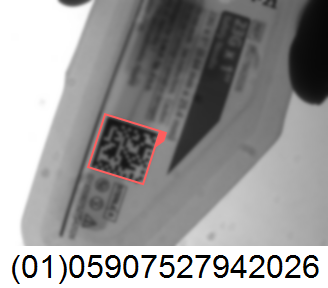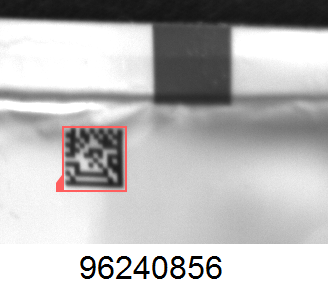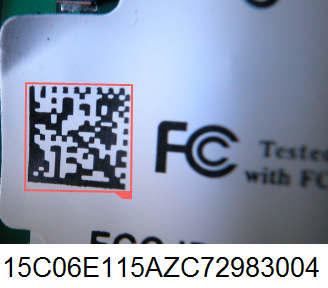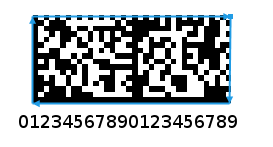Back to Adaptive Vision Library website

You are here: Start » Function Reference » Datacodes » ReadSingleDataMatrixCode
ReadSingleDataMatrixCode
Detects and recognizes one Data Matrix code.
| Header: | AVL.h |
|---|
Syntax
C++
C#
void avl::ReadSingleDataMatrixCode ( const avl::Image& inImage, atl::Optional<const avl::Rectangle2D&> inRoi, atl::Optional<const avl::CoordinateSystem2D&> inRoiAlignment, const avl::DataMatrixCodeParams& inCodeParams, const avl::DataMatrixDetectionParams& inDetectionParams, atl::Conditional<avl::DataCode>& outDataMatrixCode, atl::Array<avl::Path>& outCandidates, atl::Optional<avl::Rectangle2D&> outAlignedRoi = atl::NIL )
Parameters
| Name | Type | Default | Description | |
|---|---|---|---|---|
 |
inImage | const Image& | Input image | |
 |
inRoi | Optional<const Rectangle2D&> | NIL | Region of interest |
 |
inRoiAlignment | Optional<const CoordinateSystem2D&> | NIL | Coordinate system for the region of interest |
 |
inCodeParams | const DataMatrixCodeParams& | Specification of codes that can be detected | |
 |
inDetectionParams | const DataMatrixDetectionParams& | Specification of the way the codes are being detected | |
 |
outDataMatrixCode | Conditional<DataCode>& | ||
 |
outCandidates | Array<Path>& | Diagnostic information about detection results | |
 |
outAlignedRoi | Optional<Rectangle2D&> | NIL | Input ROI after transformation (in the image coordinates) |
Description
This filter detects and recognizes one data matrix code on an image.
Supported code types: ECC 200 and ECC 000-140.
Hints
- Specify the range of possible codes on an image by setting the inCodeParams input. The more narrow is the specification, the faster the filter works.
- Set inCodeParams.Polarity to specify whether dark-on-bright or bright-on-dark codes are to be read.
- Specify the range of possible code sizes with inCodeParams.MinRowCount, inCodeParams.MaxRowCount, inCodeParams.MinColumnCount, inCodeParams.MinColumnCount.
- Specify the range of possible module sizes (in pixels) with inCodeParams.MinModuleSize and inCodeParams.MaxModuleSize.
- Set inCodeParams.ExpectedGapSize according to the following rules:
- Zero – no gaps at all (modules are fully filled).
- Small – gaps up to 25% of the module size.
- Medium – gaps up to 50% of the module size; it may require a bigger Quiet Zone.
- Large – gaps up to 75%; comes with no guarantee.
- Modify inCodeParams.MaxRectangleRatio if you expect to work also with non-square codes. The value specifies maximal ratio between the length of the longer side to the length of the shorter side.
- If some codes are not detected, try modifying inDetectionParams:
- Increase inDetectionParams.ContrastThreshold if the noise is high. Decrease it, if the noise is low and the difference between the bright and the dark modules is low.
- Use inDetectionParams.DynamicSNRatio if there is non uniform illumination or background contamination near the quiet zone.
- Turn on inDetectionParams.NonBinarySegmentation if there are very dark or very bright pixels close to the quiet zone.
- Choose "FinderPattern" value for inDetectionParams.DetectionMethod if the quiet zone can be distorted or contaminated.
- Set inDetectionParams.PyramidStrategy to "Strict" if you want to increase reliability at the cost of higher execution time.
- If you are having problems with reading codes from low quality images, consider adding image morphology or smoothing.
Examples

DataMatrix on blurry image. |

Low quality DataMatrix code. |

DataMatrix on chip. |

Rectangular DataMatrix code. |
Remarks
For more information about local coordinate systems please refer to the following article.
See Also
- ReadMultipleDataMatrixCodes – Detects and recognizes several Data Matrix codes.

